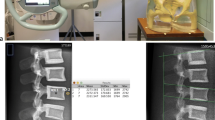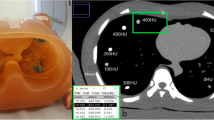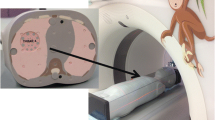Abstract
Summary
Cadaver and phantom measurements and simulations confirmed that radiation exposure in 3D QCT of the spine can be reduced if 80 kV instead of 120 kV protocols are used; 120 mAs and slice thicknesses of 1–1.3 mm should be usable but obese patient will require higher milliampere-second settings.
Purpose
To develop a low-radiation exposure CT acquisition protocol for 3D QCT of the thoracolumbar spine.
Methods
Twenty-six cadavers were scanned with a standard protocol of 120 kV, 100 mAs and with a low-dose protocol using 90 kV, 150 mAs. The scan range included the vertebrae T6 to L4. Each vertebra was segmented and the integral volume and BMD of the total vertebral body were determined. Effective dose values were estimated. The impact of milliampere-second reduction on image quality was simulated by adding noise.
Results
One hundred ninety-six vertebrae were analyzed. Integral volume as well as integral BMD correlated significantly (p < 0.001) between standard and low-dose protocols (volume, r 2 = 0.991, residual root mean square (RMS) error, 0.77 cm3; BMD, r 2 = 0.985, RMS error, 4.21 mg/cm3). The slope significantly differed from 1 for integral BMD but not for volume hinting at residual field inhomogeneity differences between the two voltage settings that could be corrected by cross-calibration. Compared to the standard protocol, effective dose was reduced by over 50 % in the low-dose protocol. Adding noise in the 90 kV images to simulate a reduction from 150 to 100 mAs did not affect the results for integral volume or BMD.
Conclusions
For 3D QCT of the spine, depending on scanner type, 80 or 90 kV instead of 120 kV protocols may be considered as an important option to reduce radiation exposure; 120 mAs and slice thicknesses of 1–1.5 mm are usable if segmentation is robust to noise. In obese patients, higher milliampere-second settings will be required.





Similar content being viewed by others
References
Engelke K, Adams JE, Armbrecht G, Augat P, Bogado CE, Bouxsein ML, Felsenberg D, Ito M, Prevrhal S, Hans DB, Lewiecki EM (2008) Clinical use of quantitative computed tomography and peripheral quantitative computed tomography in the management of osteoporosis in adults: the 2007 ISCD official positions. J Clin Densitom 11(1):123–162
Lewiecki EM, Keaveny TM, Kopperdahl DL, Genant HK, Engelke K, Fuerst T, Kivitz A, Davies RY, Fitzpatrick LA (2009) Once-monthly oral ibandronate improves biomechanical determinants of bone strength in women with postmenopausal osteoporosis. J Clin Endocrinol Metab 94(1):171–180
Brixen, K., R. Chapurlat, A.M. Cheung, T.M. Keaveny, T. Fuerst, K. Engelke, R. Recker, B. Dardzinski, N. Verbruggen, S. Ather, E. Rosenberg, and A.E. de Papp (2013) Bone density, turnover, and estimated strength in postmenopausal women treated with odanacatib: a randomized trial. J Clin Endocrinol Metab, 2013/01/23
Yang L, Sycheva AV, Black DM, Eastell R (2013) Site-specific differential effects of once-yearly zoledronic acid on the hip assessed with quantitative computed tomography: results from the HORIZON Pivotal Fracture Trial. Osteoporos Int 24(1):329–338, 2012/11/07
Glüer, C.-C., M. Krause, O. Museyko, B. Wulff, G. Campbell, T. Damm, M. Daugshies, G. Huber, Y. Lu, J. Pena, S. Waldhausen, J. Bastgen, K. Rohde, I. Steinebach, F. Thomsen, M. Amling, R. Barkmann, K. Engelke, M. Morlock, J. Pfeilschifter, and K. Püschel, New horizons for the in vivo assessment of major aspects of bone quality: microstructure and material properties assessed by Quantitative Computed Tomography and Quantitative Ultrasound methods developed by the BioAsset consortium. Osteologie, submitted
Kalender WA (1992) Effective dose values in bone mineral measurements by photon absorptiometry and computed tomography. Osteoporos Int 2:82–87
Funama Y, Awai K, Nakayama Y, Kakei K, Nagasue N, Shimamura M, Sato N, Sultana S, Morishita S, Yamashita Y (2005) Radiation dose reduction without degradation of low-contrast detectability at abdominal multisection CT with a low-tube voltage technique: phantom study. Radiology 237(3):905–910, 2005/10/21
Karmazyn B, Liang Y, Klahr P, Jennings SG (2013) AJR Am J Roentgenol 200(5):1001–1005, 2013/04/27
Tang K, Wang L, Li R, Lin J, Zheng X, Cao G (2012) Effect of low tube voltage on image quality, radiation dose, and low-contrast detectability at abdominal multidetector CT: phantom study. J Biomed Biotechnol 2012:130169, 2012/05/24
Murakami Y, Kakeda S, Kamada K, Ohnari N, Nishimura J, Ogawa M, Otsubo K, Morishita Y, Korogi Y (2010) Effect of tube voltage on image quality in 64-section multidetector 3D CT angiography: Evaluation with a vascular phantom with superimposed bone skull structures. AJNR Am J Neuroradiol 31(4):620–625, 2009/11/28
Kalender WA, Klotz E, Suess C (1987) Vertebral bone mineral analysis: an integrated approach with CT. Radiology 164(2):419–423, 1987/08/01
Genant HK, Cann CE, Ettinger B, Gordan GS (1982) Quantitative computed tomography of vertebral spongiosa: a sensitive method for detecting early bone loss after oophorectomy. Ann Intern Med 97(5):699–705
Kalender WA, Schmidt B, Zankl M, Schmidt M (1999) A PC program for estimating organ dose and effective dose values in computed tomography. Eur Radiol 9(3):555–562, 1999/03/23
Zankl, M., W. Panzer, and G. Drexler (1991) The calculation of dose from external photon exposures using reference human phantoms and Monte Carlo methods. Part VI: Organ doses from computed tomographic examinations, Munich
ICRP, The 2007 Recommendations of the International Commission on Radiological Protection, ICRP 103. Ann ICRP, 2007. 37(2–4)
Genant HK, Boyd D (1977) Quantitative bone mineral analysis using dual energy computed tomography. Invest Radiol 12(6):545–551
Cann CE (1988) Quantitative CT for determination of bone mineral density: a review. Radiology 166:509–522
Kalender WA, Deak P, Kellermeier M, van Straten M, Vollmar SV (2009) Application- and patient size-dependent optimization of X-ray spectra for CT. Med Phys 36(3):993–1007, 2009/04/22
Glüer CC, Genant HK (1989) Impact of marrow fat on accuracy of quantitative CT. J Comput Assist Tomogr 13(6):1023–1035
Laval-Jeantet AM, Roger B, Bouysee S, Bergot C, Mazess RB (1986) Influence of vertebral fat content on quantitative CT density. Radiology 159(2):463–466, 1986/05/01
Abul-Kasim K (2010) Low-dose spine CT: optimisation and clinical implementation. Radiat Prot Dosim 139(1–3):169–172
Mulkens TH, Marchal P, Daineffe S, Salgado R, Bellinck P, te Rijdt B, Kegelaers B, Termote JL (2007) Comparison of low-dose with standard-dose multidetector CT in cervical spine trauma. AJNR Am J Neuroradiol 28(8):1444–1450, 2007/09/12
Nakayama Y, Awai K, Funama Y, Hatemura M, Imuta M, Nakaura T, Ryu D, Morishita S, Sultana S, Sato N, Yamashita Y (2005) Abdominal CT with low tube voltage: preliminary observations about radiation dose, contrast enhancement, image quality, and noise. Radiology 237(3):945–951, 2005/10/21
Acknowledgments
This project was supported by the German Federal Ministry of Education and Research (BMBF, BioAsset 01EC1005D).
Conflicts of Interest
None.
Author information
Authors and Affiliations
Corresponding author
Rights and permissions
About this article
Cite this article
Museyko, O., Heinemann, A., Krause, M. et al. A low-radiation exposure protocol for 3D QCT of the spine. Osteoporos Int 25, 983–992 (2014). https://doi.org/10.1007/s00198-013-2544-x
Received:
Accepted:
Published:
Issue Date:
DOI: https://doi.org/10.1007/s00198-013-2544-x




